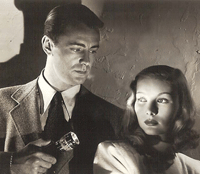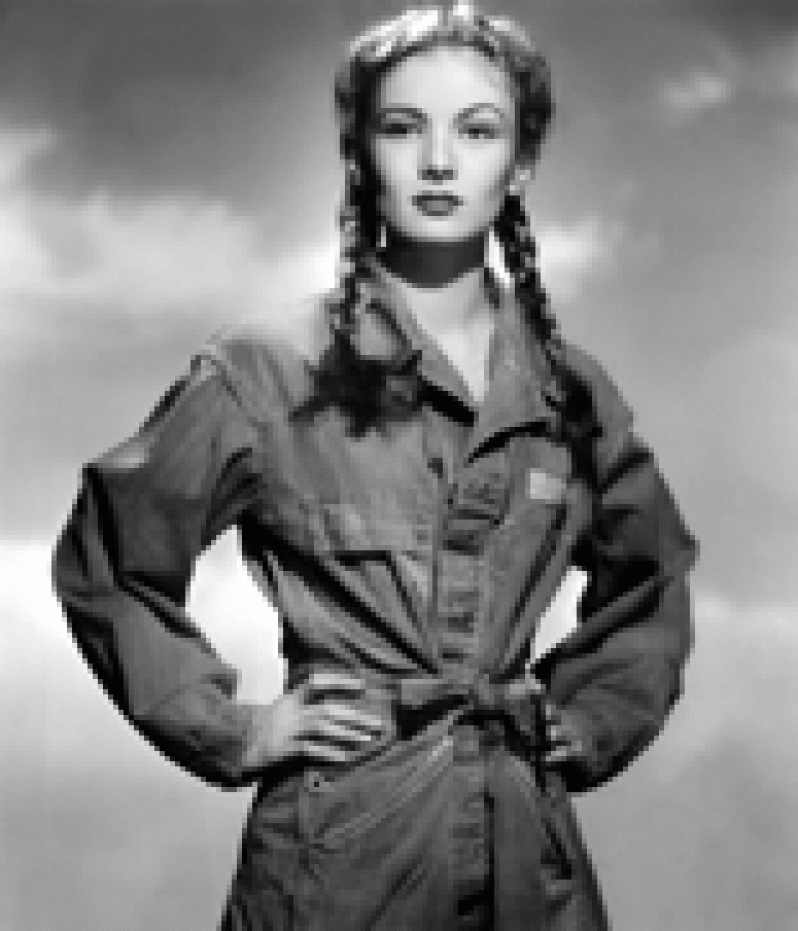ONE becomes a screen legend when the roles one play do not serve simply to make one rich and famous, but influence the human standards, attitude, and fashion appearance of those who pay attention to film roles.  The reason why Veronica Lake emerged as a screen legend since her early 1941 films, such as ‘I WANTED WINGS’ and ‘HOLD BACK THE DAWN’, is simple: She delivers the same style of an underlying personality, despite the difference in characters she is playing. How is that possible? Good question, which defines the difference between actresses who apply the attractive qualities of their already formed personality to the role required, and those who just routinely ‘get into’ or adjust to the character role required.
The reason why Veronica Lake emerged as a screen legend since her early 1941 films, such as ‘I WANTED WINGS’ and ‘HOLD BACK THE DAWN’, is simple: She delivers the same style of an underlying personality, despite the difference in characters she is playing. How is that possible? Good question, which defines the difference between actresses who apply the attractive qualities of their already formed personality to the role required, and those who just routinely ‘get into’ or adjust to the character role required.
Lake became a screen star legend that will not die, because every time we see a film role with her, different from the others, the same spell-binding human (and quite feminine) qualities keep coming through.
What are those qualities? A sultry expectancy; a silent attentiveness; a sympathetic ear; a gradual and committed romantic attractiveness; a coy and very suave tone of voice and sense of humour; a firm intellectual commitment to professional and social values, whether in the arts, crime-fighting, or espionage; a clean, lean appearance and fashion style.
Lake & Paramount
It is apparent that Lake’s display of these personality traits in her character roles was only possible because of the combined creative knowledge and permissiveness of her film studio, her screen writers, and film directors. This is a crucial fact that never fails to re-emphasize just how positive and utopian Hollywood at its best was during the 1940s, one of its greatest decades, when the American State, under Franklin D Roosevelt, exercised highly creative and non-discriminatory productive and unifying socialist values.
Lake was part of a batch of vibrant, new screen talent with whom Paramount Studios had replaced its expensive popular screen stars, like Marlene Dietrich, Claudette Colbert, Gary Cooper, and Mae West, among others. These well-known stars had been highly paid in expensive genres, which pushed the studio budget up without doing anything really progressive in the film industry.
Paramount, which prided itself on giving its film directors authority and creative freedom, brought in a new batch of less expensive, lesser known actors and actresses, such as Bob Hope, Ray Milland, Fred MacMurray, Dorothy Lamour, Paulette Goddard (a bright Hollywood liberal), and Veronica Lake. The result was a surge of exuberant and off-beat engaging Paramount films, where the consistent linguistic and physical personality traits of these screen stars took precedence as a style over routine characterizations.
Attractiveness Lake’s attractiveness on screen is achieved by her portrayal of personal human qualities, in contrast to group traits attached to a specific racial or ethnic culture. In other words, is Lake’s sympathy for child-abused Alan Ladd in ‘THIS GUN FOR HIRE’ (1942), or her quiet caring for him as a jilted husband in ‘THE BLUE DAHLIA’ (1946), or her eventual romantic preference for him as the bodyguard of her rich-husband-to-be politician in ‘THE GLASS KEY’ (1942), or her espionage work against Nazism, her crime fighting and nightclub singing in ‘This Gun for Hire’ only attributed to white Anglo-Saxon women, or women of Ireland, England, America, etc, making these films ‘only’ for them? Or are such attitudes or qualities really quite human qualities common to all women who choose to cultivate themselves?
Lake’s attractiveness on screen is achieved by her portrayal of personal human qualities, in contrast to group traits attached to a specific racial or ethnic culture. In other words, is Lake’s sympathy for child-abused Alan Ladd in ‘THIS GUN FOR HIRE’ (1942), or her quiet caring for him as a jilted husband in ‘THE BLUE DAHLIA’ (1946), or her eventual romantic preference for him as the bodyguard of her rich-husband-to-be politician in ‘THE GLASS KEY’ (1942), or her espionage work against Nazism, her crime fighting and nightclub singing in ‘This Gun for Hire’ only attributed to white Anglo-Saxon women, or women of Ireland, England, America, etc, making these films ‘only’ for them? Or are such attitudes or qualities really quite human qualities common to all women who choose to cultivate themselves?
Amazingly, another brilliant film answered that question in the 1960s: ‘LE SAMOURAI’, directed by Jean-Pierre Melville, where Alain Delon, replaying the same role of Alan Ladd in ‘This Gun for Hire’ (Ladd’s only friend is a cat, while Delon’s only friend is a bird in a cage) is reformed by a beautiful black female singer in a Paris nightclub.
Lake’s physical and fashion style, her cute slimness, childish features, witty speech, her little caps and ‘peek-a-boo’ hairstyle drooping over one eye, are mostly what we keep hearing about her today; not her pleasant social attitudes in most of her roles.
During the 1940s, Lake was so popular among working-class female factory workers who imitated her hairstyle and wore it to work, that their hair got caught in machinery, and the style was banned by their employers.




.png)









